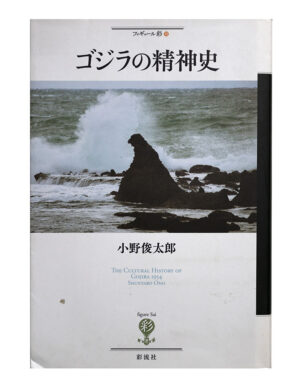10.10.2022
The Cultural History of Godzilla – Pt 16


P 38
叙事詩の英雄には死が待っていて、ロマンス物語の主人公には結婚と幸せな生活が待っている。そして、同年輩でも芹沢博士は戦前の価値観につながり、尾形は戦後の価値観につながるとみなせる。二人の立場の違いを、潜水服を身に着けるときの頭の鉢巻の結び方の違いに見たのが、加藤典洋の「さようなら、ゴジラたち』である。尾形は漁師がやるあんちゃん巻きをしていて、芹沢博士は特攻隊の巻き方をしているという映像的な差異が、その後の運命を示すと加藤はみなしている。
Death awaits the epic hero, marriage and a happy life await the hero of the romance story. And even among people of the same age, Dr. Serizawa is connected to the prewar values, and Ogata is connected to the postwar values. Kato Norihiro’s “Sayonara, Godzilla Tachi” saw the difference in the positions of the two men in the way they tied the headband when wearing the diving suit. Kato believes that the visual difference that Dr. Serizawa is doing the kamikaze corps shows the fate after that.
加藤の読解を踏まえると、芹沢博士の研究室でオキシジェン・デストロイヤーの使用をめぐって争ったときに尾形が怪我をして、流れた血を止めるために恵美子に白い包帯を巻かれるのも別の意味がありそうだ。 それが特攻隊とおなじ鉢巻の巻き方となり、その時点での尾形の決意を表していたともいえる。恋のライバルである尾形は、自分で潜水をしてオキシジェン・デストロイヤーを使ってゴジラを倒すつもりでいた。だが、本来の英雄である芹沢博士が、偽の英雄である尾形から武器を奪い返すことになる。
Based on Kato’s reading, it also makes sense that Ogata gets injured during a fight over the use of the Oxygen Destroyer in Dr. Serizawa’s lab, there seems to be another meaning to Emiko wrapping white bandages to stop the bleeding. That became the same way of wrapping headbands as kamikaze corps, and it can be said that Ogata’s determination at that time was expressed. His love rival, Ogata, intends to submerge himself and use the Oxygen Destroyer to defeat Godzilla. However, the original hero, Dr. Serizawa, will take back the weapon from the fake hero, Ogata.
英雄は敵を倒すことで集団を救済するわけだが、同時に英雄はアキレス腱のような弱点をもつ。天スティグマ が与えた「聖痕」ともいえるものだ。芹沢博士もアイパッチで片目を隠す「隻眼」という弱点を抱えているからこそ、じつは英雄の資格をもっている。日本の物語文化の伝統では、刀の鍔で片目を隠していた剣豪柳生十兵衛や悲劇のヒーローである森の石松のイメージとも重なる。そしてオキシジェン・デストロイヤーという現代の「剣」によってゴジラを倒すのだ。そもそもアーサー王のエクスカリバーや英雄ジークフリートのノートゥングや『南総里見八犬伝』に出てくる名刀村雨丸のように、すぐれた刀剣は固有の名前をもつではないか。「オキシジェン・デストロイヤー」がたとえば「発明第百三十二号」などといった無味乾燥な名前では物語が動き出さない。
A hero saves a group by defeating an enemy, but at the same time, a hero has a weakness like an Achilles’ heel. It can be said to be a “stigmata” given by the heavenly stigma. Dr. Serizawa also has the weakness of “one eye” that hides one eye with an eye patch, so he actually has the qualifications of a hero. In the tradition of Japanese narrative culture, it overlaps with the image of the master swordsman Jubei Yagyu, who had one eye hidden by the sword guard, and the tragic hero Ishimatsu Mori. And he defeated Godzilla with a modern “sword” called Oxygen Destroyer. In the first place, like King Arthur’s Excalibur, the hero Siegfried’s Notung, and the famous sword Muramaru Amemaru in “Nanso Satomi Hakkenden,” don’t great swords have their own names? A dry name like “Invention No. 132” for “Oxygen Destroyer” doesn’t get the story moving.

P 39
こうして見てくると『ゴジラ』という映画は、英雄である芹沢博士がオキシジェン・デストロイヤという武器でドラゴンであるゴジラと戦うという基本の図式をもつからこそ、そこに民族のさまざまな感情や価値観を盛りこむ「英雄叙事詩」となりえた。それがおそらくゴジラを殺すことが出来ないでいる後続のゴジラ映画と初代の『ゴジラ』との決定的な違いである(もう一度ゴジラが死んだとされる一九八四年の『ゴジラ』については第七章で触れる)。脅威を与えた怪物は退治されて帰ってこないが、退治した英雄もまた帰ってこない。私たちの心を揺さぶる根底にあるのがこの図式なのだ。
Looking at it in this way, the movie “Godzilla” has a basic scheme in which the hero Dr. Serizawa fights the dragon Godzilla with a weapon called Oxygen Destroyer. It could have been a “heroic epic” to be filled. That’s probably the decisive difference between the subsequent Godzilla movies, which are unable to kill Godzilla, and the first Godzilla (The 1984 “Godzilla,” in which Godzilla is said to have died once more, will be discussed in Chapter 7). The monsters that threatened them are exterminated and do not return, but the defeated heroes also do not return. It is this scheme that underlies our hearts and minds.